If you have ever seen a bristle worm in your reef tank, you probably agree they can be ugly little creatures. I’m pretty sure we’re genetically programmed to get creeped out by millipede-like invertebrates. And once you start looking, you’ll find TONS of energy and discussion about this lowly polychaete in reef aquarium circles. The bristle worm is a live rock hitchhiker that reef tank owners love to hate. Is there merit to all of the debate, or is it a bit over-blown? Let’s dig into the topic and see if we can separate the dirt from the detritus.
Table of Contents
Obviously, people feel strongly about the bristle worms they find in their aquariums. (By the way, “bristleworms” is also acceptable – the name works either way) And if you have a specific question and want to jump right to that section, these handy links will work. But if you’re still on the fence and unsure what to think, this ultimate guide to the pest (or beneficial clean-up crew member) might help you decide which camp to join.
- What is a Bristle Worm?
- What Do Bristle Worms Do?
- Where Do Bristle Worms Come From?
- Parasite or Pest (Or Something More)?
- What Do Bristle Worms Eat?
- Can Bristle Worms Kill Fish?
- Good, Bad, or Just Ugly?
- Are Bristle Worms Dangerous?
- Can You Touch a Bristle Worm?
- Bristle Worm Infestation
- Eliminating Bristle Worms
- Letting Bristle Worms Lie?
- For More Information

What is a Bristle Worm?
A bristle worm is a small, cryptic (lives in dark parts of your reef) segmented worm that often lives in a reef aquarium’s live rock and sand. The “bristle” part of their name comes from the tufts of hair that poke out between each segment. These “hairs” provide protection from predators.
(and they’re an important feature you’ll need to keep in mind as we go further into our discussion). It’s also part of identifying the group of segmented worms they belong to: the polychaetes. Polychaete means “many hairs” in Latin – a common feature in any of the bristle worms you’ll encounter.
Most aquarists spot them when they’re small – around 1-6 inches (2.5-15.2cm) long. But if they find proper nourishment and remain undetected in your reef tank? They can grow up to 24 inches (61cm)! Sound impossible? It’s actually pretty easy. They’re nocturnal and like to stay under your live rock or in the deep sand bed. So unless you’re performing a “snipe hunt” specifically for them, you can easily miss these little guys.
They don’t even mind hanging out in strange places. These two little bristle worms thought my sponge filter made a nice home before I caught them:
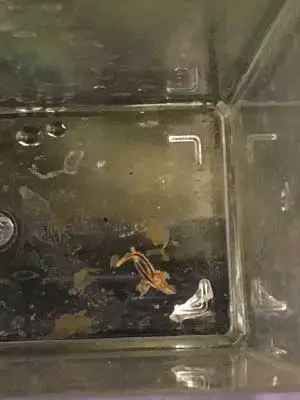
What Do Bristle Worms Do?
Bristle worms are scavenging detritivores. They feed on uneaten food, detritus, and carrion (dead things in your aquarium). Whether or not they are helpful in a saltwater aquarium is sometimes a controversial topic.
That’s a TON of potential waste that could turn into ammonia and overwhelm your biological filter. And since the materials already feature on the bristle worm menu, they’re happy to pitch in and take away the problem. It’s a cleanup process they perform in the wild – you just may not see it the way you will with your fish or shrimp.
Where Do Bristle Worms Come From?
Bristleworms hide within tiny crevices in reef-building rocks and are likely introduced into an aquarium unknowingly when new live rock is added to the tank. The introduction may go unnoticed for months, as their natural behavior is to emerge only at night when the lights out off.
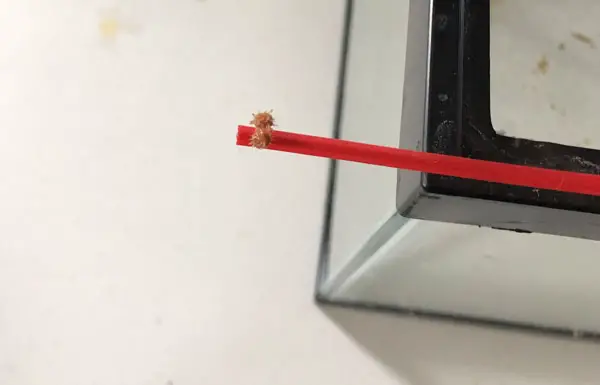
Parasite or Pest (Or Something More)?
Generally, when you think of an unwanted pest, the word “parasite” comes to mind. And since bristle worms hitchhike on live rock, you may lean even heavier in that direction. These polychaetes certainly LOOK gruesome enough to fit the bill. But they’re actually NOT parasites. By definition, a parasite lives in or on a host and feeds off the host. Bristle worms are detritivores, meaning they sift through and eat things in the detritus, including dead and decaying matter. Your tank BENEFITS from their activities, which runs counter to the description of a parasite. (And it’s part of the debate that clogs those message boards)
Of course, some species of bristle worm CAN cause harm. And that’s where the “pest” definition comes into play. Fireworms, in particular, have no problem stinging other invertebrates – including your corals. They can even target small, sleeping fish. And since they reproduce at a rapid rate, it doesn’t take long for them to infiltrate a tank. You don’t want them, and you NEED to get rid of them. That falls clearly into the definition of a pest.
There ARE parasitic polychaetes in nature, but the odds that you’ll encounter them in your aquarium are slim.
What Do Bristle Worms Eat?
Bristle worms are scavenging detritivores. They eat decaying matter (food or carcasses), as well as detritus.
Most of us happily pay good money to add cleanup crew members to our reef tanks. So why is there so much fuss about this pesky polychaete? Some of it probably comes from the negative stigma associated with their chosen meals. Especially when you spot a group of bristle worms snacking on a fish carcass. So let’s address that question next.
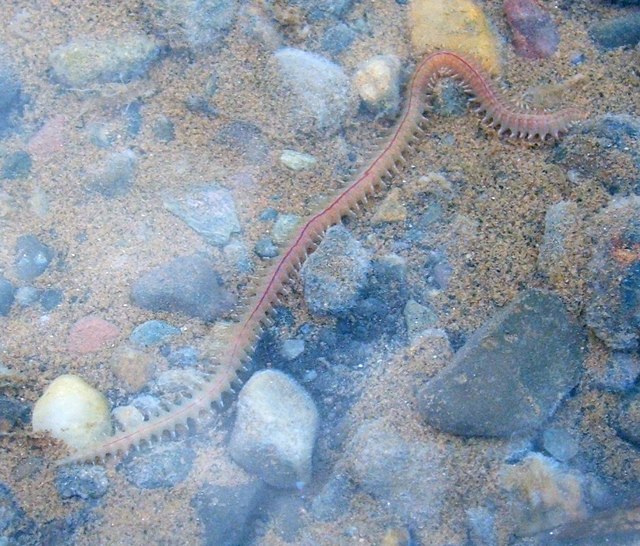
Can Bristle Worms Kill Fish?
Bristle worms are scavengers and will not harm your fish. Aquarists report seeing bristle worms feeding on a dead fish during daylight hours, but the polychaetes in this situation most likely arrived well after the fish had died and started decaying.
Fireworms (especially the Pherecardia and Hermodice genera) can cause more problems. They’re official carnivores. The bristles along their bodies carry toxins that produce stings. And they’re painful to corals, crustaceans, mollusks, and even other bristle worms! If fireworms come across fish small enough (and slow enough), they’ll attack them, too. In that case, you’ll end up with a dead fish.
This is why it’s important to pay attention to the appearance of the bristle worms in your tank. Technically, ANY polychaete is considered a bristle worm. But only fireworms have the power to kill fish – or make you wish you’d donned heavy gloves!
Good, Bad, or Just Ugly?
Now that you have those notes in mind, you can probably guess that there are “good” and “bad” bristle worms out there. Luckily, the usually tufted inverts you’ll come across are the “garden variety” bristle worms that want to pitch in on your cleanup crew. They won’t bother your tank residents, and they’re not going to turn into a major problem. You don’t see fireworms show up very often. But because of the damage fireworms can wreak in an aquarium, it’s important to know how to recognize them.
This Youtube video shows the difference between the two in a handy side-by-side comparison:
And in case you weren’t convinced about the damage a fireworm can cause? This YouTube video shows a fireworm actively roving for a meal:
Are Bristle Worms Dangerous?
Now that you’re suitably frightened (and don’t feel like sticking your fingers in your aquarium ever again) let’s calm things back down. Remember, the vast majority of bristle worms you’re going to encounter are regular old polychaetes. They are NOT dangerous to humans. They won’t even bother your fish, corals, or crustaceans. You may get squeamish at the sight of a worm squirming around in your tank, but it’s not going to bother you (or think twice about your presence).
However, there is a small chance that a fireworm made its way into your tank. And because of that little problem child (and since these polychaetes prefer to hang out under rocks and in the sand – where you can’t see them), you should take some precautions. Obviously, you need to quarantine and thoroughly examine any live rock or sand you plan to add to your display tank (that’s basic logic). But whenever you work in your aquarium? A thick set of gloves will protect your hands from an errant fireworm.

Can You Touch a Bristle Worm?
The sting you get from a bristle worm feels like touching a small cactus or getting a series of splinters. It burns a little the skin feels irritated for a few hours, but otherwise no major issues.
I report that from my first “hand” experience. (Get it? First hand?) That’s my hand in the picture below, and I’ll walk you through my experience with touching a bristle worm.
The first sensation is a needle-puncture sensation. Sharp and painful enough to make you pull your arm back (courtesy of your spinal reflexes). You may even make a whelping sound that your daughters will make fun of for years into the future (totally hypothetically, there. I’m not basing that on a personal reference or anything).
Then, the tiny bristles will remain stuck in your skin and start to irritate the skin, much like a splinter. The affected area remains tender for a while. You can see me pulling the bristles out of my finger in that image. They’re tiny and require tweezers.
Now, do you see why you should ALWAYS wear gloves when working in your tank – JUST IN CASE?
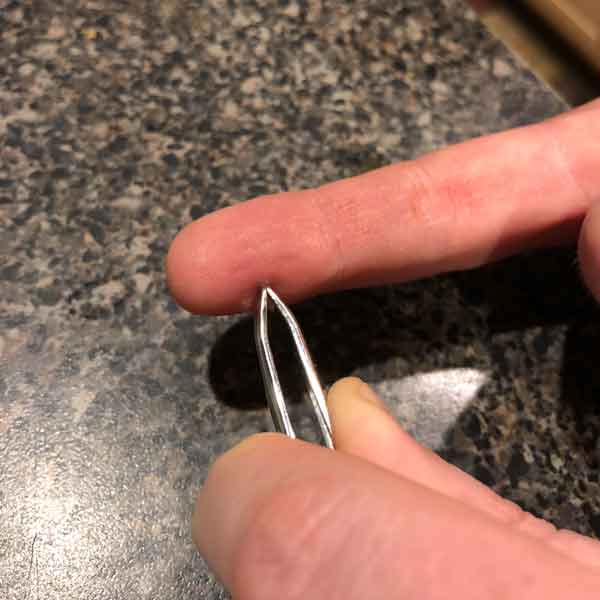
Bristle Worm Infestation
You can identify your helpful bristle worms from the fireworms you don’t want around. But you feel like you see bristle worms EVERYWHERE. That makes them shift over into the pest category, right? And that means they’re a problem that’s gotten out of control. They clearly need to go. They’ve overstayed their welcome. (You’ll find this argument show up all the time on the message boards)
Having too many bristle worms in a reef tank is a symptom of a bigger problem, and it’s NOT the worms themselves. You see, if you have a ton of bristle worms, you have a ton of dead animals or leftover food rotting in your tank. Without that waste, you wouldn’t see the bristle worm population explosion. The resources are supporting all of the worms. So – in one way of thinking about it – they are a very, very good thing. Without them, you’d probably have foul water. Instead, you have a zillion polychaetes chowing down on the imperfections of your aquarium.
But if seeing bristle worms crawling around your tank gives you the creeps, you need to consider eliminating them. And after you’ve dealt with the BIGGER issue, you can move on to pest control.
Eliminating Bristle Worms
When you start considering bristle worm elimination, there are three primary ways:
- Physically remove them when you see them (Remember, though, DON’T touch them!)
- Trap them inside a bristle worm trap (store-purchased or DIY)
- Add a predator to eat them
Physical Removal
Since you’ve already learned your lesson (well, MY lesson) about touching bristle worms, you know you need to think of alternative methods for snatching up these little cleanup crew members. And that means you need some sort of grabbing or scooping gadget to remove them safely. Sometimes you can suck them up with a gravel vacuum or a turkey baster. Other times, tweezers work nicely.
Since you know they like to hang out in the crevices and crannies of your live rock, consider transferring the rocks into a plastic container of saltwater. Gently stir the water around to create a current and draw the worms out. They’ll float to the surface.
The process is fairly straightforward after that: See ’em, get ’em.
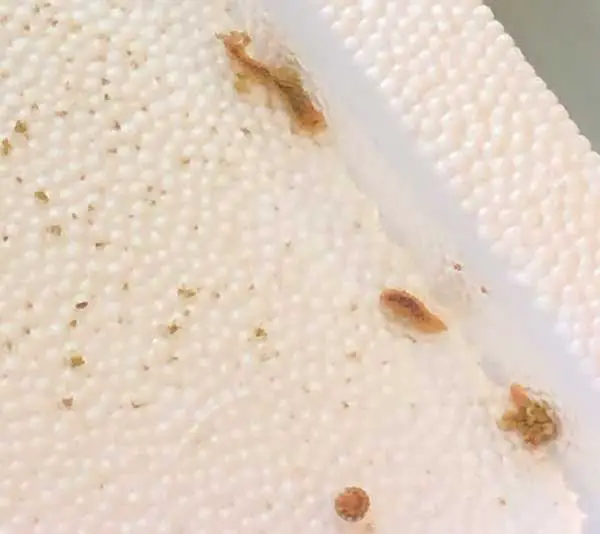
Creating a DIY Bristle Worm Trap
Physical removal IS tedious. And it requires a keen eye and quick reflexes. So if you’re interested in trapping the little buggers while you sleep, you’ll want to consider a bristle worm trap. You CAN purchase such things, of course, but I have two potential designs you can mark using plastic stuff around your house.
Please be careful when making them! They involve cutting thin plastic, which gets quite sharp (in my experience).
Design 1: DIY Soda Bottle Bristle Worm Trap
The soda bottle conversion into a bristle worm trap is a classic design that works for plenty of underwater critters, including polychaete worms. Since most bristle worms are pretty small, I recommend using the 12 or 20-ounce size. Learning how to make a trap like this has turned into a fairly handy skill for me. I’ve used the same design to trap all sorts of things: fruit flies, minnows, shrimp, and (of course) bristle worms.
Step 1: Cut off the top of the bottle with scissors or a knife. Your line doesn’t need to be super-straight, although the trap will look nicer and have fewer jagged edges if you do. Be careful; the plastic edges will be sharp!

Step 2: Unscrew the cap so that the top of the bottle remains open. Invert the top part of the bottle, so the screw top goes inside the bottle’s body.

Step 3: Superglue or silicone the sides to seal the bottle trap. Remember, these are tiny creatures, and you don’t want them to escape.
When I’ve used this design to trap other things (not in my reef tank), I’ve used duct tape to seal the edge (way easier than glue). The problem is, I don’t know what’s in the adhesive and don’t want to recommend it for your reef tank. But think of that as a concept: you want to seal the edges as best you can with reef-safe materials.
It’s also possible to wedge the plastic in well enough that you can get a decent seal without any glue or silicone. In my experience, one side (or more) will pucker, buckle or fold, creating a small gap a small invertebrate can escape through. Focus your plug on that spot. You can also try it out and see if you trap (and keep) any bristle worms without the extra adhesive step.
 Step 4: Place rotting, stinking bait inside the trap. Lay the trap sideways on the bottom of your tank, and go to sleep. You may need to weigh the trap down to get it to stay in one place.
Step 4: Place rotting, stinking bait inside the trap. Lay the trap sideways on the bottom of your tank, and go to sleep. You may need to weigh the trap down to get it to stay in one place.See what you can catch the next morning. The basic premise of the soda bottle design is that worms will climb in to get the free meal and won’t climb back out (hopefully). Don’t leave the rotting food in there too long (e.g., not for multiple days). You don’t want to ruin your water quality.
Design 2: DIY Food Storage Container Bristle Worm Trap
I also found a DIY bristle worm trap design on Reef Builders that involves a small, rectangular food storage container with a lid. For this design, you want to use the flattest container possible. You’ll create four triangular-shaped flaps. By bending those flaps inward, you create a funnel design that is easier to get in than getting out.
Step 1: Cut an “X” through the top of the lid, creating four SHARP plastic triangles that flex in the middle.
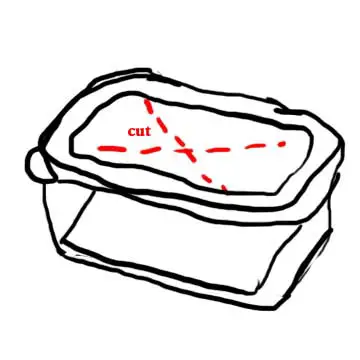
Step 2: Push each of the triangles down and bend them to create a semi-permanent gap large enough to catch some worms. Be careful when you do this! The sides of the plastic will be thin and sharp. They can and will slice your finger!

Step 3: Bait your trap with something gross (frozen food left out all day works well). Set it on the bottom of your tank, and see what you get.
Both of these DIY bristle worm trap designs work similarly. You put bait in a container, make it easy for small things to slip in, and make it difficult (but not impossible) for them to get back out. The worm doesn’t realize it’s trapped and doesn’t pay much attention to how it got in. This means it won’t make its way back out. At least, not without occasional random luck or persistent exploration.
Live Bristle Worm Pest Control
Even with handy DIY solutions available, not every aquarist wants to use traps to handle a bristle worm infestation. And that’s where Mother Nature can step in. The eat-or-be-eaten underwater world fascinates me. While the bristles on these polychaetes sting (I can attest to that), discouraging some reef inhabitants from nibbling on them, several predators will happily dine on them. And that’s where live pest control comes in. You can easily add these invertebrates and fish to your display tank and watch those bristle worms dwindle in numbers.
What are some Bristle worm predators?
Popular aquarium bristleworm predators that will eliminate them from your tank naturally are:
- Arrow crab
- Boxer shrimp
- Neon dottyback
- Orchid dottyback
- Flame hawkfish
- Longnose hawkfish
- Melanurus wrasse
- Six line wrasse
- Coris wrasse
It is worth adding a disclaimer here that when you choose a natural biological control to take care of your bristle worm (or any other natural problem), it isn’t guaranteed. Individual results vary. Sometimes your predator decides they’re not interested in eating bristle worms (even if the polychaetes are normal parts of the menu). Other times they do an imperfect job, picking at the worms as an occasional snack rather than hunting them down as a full meal.
And if you’re ONLY choosing these species for pest control? You need to have a plan for them once your bristle worms exit the tank. Where will you move your new inverts or fish? If you don’t have a plan of action, your “pest control” can quickly turn into a new problem in the aquarium.
It’s an Invertebrate-Eat-Invertebrate World
You don’t mind the fact that bristle worms participate as members of the cleanup crew. You just don’t want SO MANY of them. So why not add some natural cleanup crews to your tank to handle the excess polychaetes? Both arrow crabs and coral banded shrimp find bristle worms (and even fireworms) delightful snacks. They’ll even pitch in with keeping your tank clean in the same manner as the worms – without looking quite so creepy.

Fish that eat bristleworms
Six commonly available aquarium fish that eat bristleworms are:
- Six line wrasse
- Longnose hawkfish
- Flame hawkfish
- Neon dottyback
- Orchid dottyback
- Melanurus wrasse
Wrasses, like the six line and Melanurus, are effective predators and even frequent the live rock and sand where bristle worms like to hide. Hawkfishes perch around coral and love to eat small invertebrates and may help the cause. Even dottybacks (orchid, neon, etc.) get in on the action. And all of these fish look stunning in a display tank – providing form AND function.

Yellow Coris wrasses may eat small ones, but probably shouldn’t be relied upon for polychaete removal.
Letting Bristle Worms Lie?
Now, just because you CAN remove bristle worms doesn’t mean that you SHOULD. That’s a personal decision. But since you asked (well, you’re here, so I’ll assume you asked), I’ll give you my perspective on the matter.
Bristle worms are IDEALLY SUITED to aquarium life. That’s why they grow and reproduce so well in saltwater tanks. Okay, so no aquarist is going to pay money for a bristle worm. We don’t invite them into our tanks, either.
But many of us (I’m raising one guilty hand) get a little sloppy with our husbandry. We feed a little too much and clean the tank a little less often than we should. And the bristle worm population in your tank helps create a natural, biological buffer. They’re the cleanup crew you didn’t intend. But Mother Nature developed them specifically for this purpose.
In addition, think about the biological diversity and invertebrate life going on in your tank. How many rotifers, copepods, Stomatella snails, hermit crabs, starfish, and other snails live and die in your tank in a given week, month, or year? I suspect you’re pretty good about removing large, dead organisms (like an unfortunate fish). But what about all those other critters? Do you catch and remove them? Or do you need (or want) a little help?
The bristle worm is nature’s cleanup crew. So my vote is to leave them alone. Monitoring the population gives you insights into how much waste is in your tank (feeding the bristle worms). But otherwise, these segmented polychaetes are a good thing(in most tanks).
The only time I would recommend removing them is if you have fireworks. Or if you absolutely can’t stand the sight of them.
For More Information
Bristle worms will probably continue to dominate message boards. But learning as much about them? That can help you decide whether they’re a pest or a blessing in disguise. And they’re not the only potential hitchhiker you’ll see sneaking in with your live rock!
This YouTube video provides a handy demonstration of that DIY bristle worm trap in action:
To learn more about other polychaete worms in the saltwater aquarium, perhaps the most popular are the feather duster worms. Learn how to care for them and see if they are right for your tank.
If you want to dive deeper into the world of live rock hitchhikers, check out the:
- Live Rock Hitchhikers Guide (Don’t panic)
Please share your thoughts, questions, and ideas!
What has your experience with bristle worms been? You can share below by leaving a comment. Thanks!

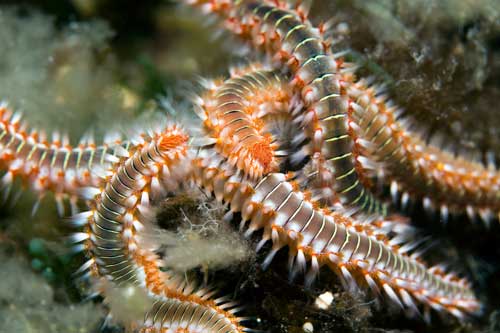

Leave a Reply